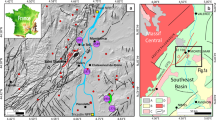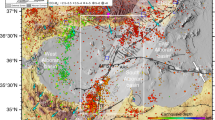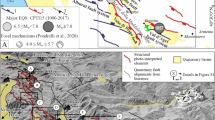Abstract
ALTHOUGH many fault ruptures are known from the boundaries of the Earth's lithospheric plates, the 'stable' interiors of continents are much less active1. Worldwide, only ten historical intraplate earthquakes are known to have produced surface faulting2 and none of these was in eastern North America. Despite the confirmed prehistoric rupture of the Meers fault3, some have wondered if intraplate earthquakes in the stable North American craton might somehow be different from plate-boundary earthquakes, and hence fail to rupture the surface4. This is an important consideration for seismic hazard assessments. When the Ungava earthquake (with magnitude (Ms) 6.3 and apparent shallow depth) occurred on 25 December 1989 in northern Canada, we (and, independently, A. Johnston of Memphis State University) concluded that it might have produced surface faulting. Here we report that there was indeed a surface rupture, 8.5 km long, with up to 1.8 m of reverse faulting on a steeply dipping, arcuate fault plane. The faulting confirms the seismological process and indicates that there is a hazard from ground-rupturing earthquakes in eastern North America, but the poor surface expression shows that finding prehistoric fault ruptures in order to constrain seismic hazard estimates will be difficult.
This is a preview of subscription content, access via your institution
Access options
Subscribe to this journal
Receive 51 print issues and online access
$199.00 per year
only $3.90 per issue
Buy this article
- Purchase on Springer Link
- Instant access to full article PDF
Prices may be subject to local taxes which are calculated during checkout
Similar content being viewed by others
References
Johnston, A. C. & Kanter, L. R. Scient. Am. 262(3), 68–75 (1990).
Johnston, A. C. & Bullard, T. Seismol. Res. Lett. 61, 152–153 (1990).
Crone, A. J. & Luza, K. V. Bull. geol. Soc. Am. 102, 1–17 (1990).
Wu, F. T. Seismol. Res. Lett. 59, 251–260 (1988).
Gordon, F. R. & Lewis, J. D. Bull. geol. Surv. W. Austr. 126, 1–229 (1980).
McCue, K. et al. EOS 68, 609–612 (1987).
Choy, G. L. & Bowman, J. R. J. geophys. Res. 95, 6867–6882 (1990).
Mansinha, L. & Smylie, D. E. Bull. seismol. Soc. Am. 61, 1433–1440 (1971).
National Earthquake Information Service Preliminary Determination of Epicenters, December 1989 (Golden, Colorado, 1990).
Ebel, J. E., Somerville, P. G. & McIver, J. D. J. geophys. Res. 91, 8231–8247 (1986).
North, R. G. et al. Seismol. Res. Lett. 60, 89–93 (1989).
Basham, P. W. Ann. N. Y. Acad. Sci. 558, 1–10 (1989).
Amick, D. & Gelenas, R. Science 251, 655–658 (1991).
Obermeier, S. F. et al. Science 251, 1061–1063 (1991).
Doig, R. Can. J. Earth Sci. 23, 930–937 (1986).
Author information
Authors and Affiliations
Rights and permissions
About this article
Cite this article
Adams, J., Wetmiller, R., Hasegawa, H. et al. The first surface faulting from a historical intraplate earthquake in North America. Nature 352, 617–619 (1991). https://doi.org/10.1038/352617a0
Received:
Accepted:
Issue Date:
DOI: https://doi.org/10.1038/352617a0
This article is cited by
-
Statistical Analysis of Intraplate Seismic Clusters: The Case of the NW Iberian Peninsula
Pure and Applied Geophysics (2021)
-
Multiscale variations of the crustal stress field throughout North America
Nature Communications (2020)
-
Pulses of carbon dioxide emissions from intracrustal faults following climatic warming
Nature Geoscience (2012)
-
Seismic Hazards Assessment for Radioactive Waste Disposal Sites in Regions of Low Seismic Activity
Geotechnical and Geological Engineering (2006)
-
Rupture histories of two stable continental region earthquakes of India
Journal of Earth System Science (1998)
Comments
By submitting a comment you agree to abide by our Terms and Community Guidelines. If you find something abusive or that does not comply with our terms or guidelines please flag it as inappropriate.



